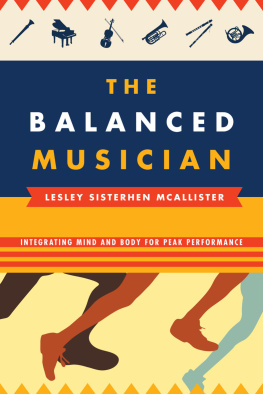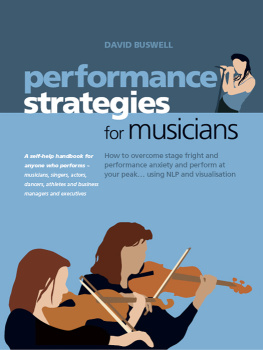The Balanced Musician
Integrating Mind and Body for Peak Performance
Lesley Sisterhen McAllister
THE SCARECROW PRESS, INC.
Lanham Toronto Plymouth, UK
2013
Published by Scarecrow Press, Inc.
A wholly owned subsidiary of The Rowman & Littlefield Publishing Group, Inc.
4501 Forbes Boulevard, Suite 200, Lanham, Maryland 20706
www.rowman.com
10 Thornbury Road, Plymouth PL6 7PP, United Kingdom
Copyright 2013 by Lesley Sisterhen McAllister
All rights reserved. No part of this book may be reproduced in any form or by any electronic or mechanical means, including information storage and retrieval systems, without written permission from the publisher, except by a reviewer who may quote passages in a review.
British Library Cataloguing in Publication Information Available
Library of Congress Cataloging-in-Publication Data
McAllister, Lesley Sisterhen, 1977
The balanced musician : integrating mind and body for peak performance / Lesley Sisterhen McAllister.
p. cm.
Includes bibliographical references and index.
ISBN 978-0-8108-8293-5 (pbk. : alk. paper) ISBN 978-0-8108-8294-2 (ebook)
1. MusicPerformancePsychological aspects. I. Title.
ML3830.M33 2013
781.4'3dc23 2012022264
 The paper used in this publication meets the minimum requirements of American National Standard for Information SciencesPermanence of Paper for Printed Library Materials, ANSI/NISO Z39.48-1992. Printed in the United States of America.
The paper used in this publication meets the minimum requirements of American National Standard for Information SciencesPermanence of Paper for Printed Library Materials, ANSI/NISO Z39.48-1992. Printed in the United States of America.
Photographs in book by Courtney Faulkner (models Elizabeth Kohl, Ariana Phillips, and Jorge Rodriguez Ochoa)
For my husband, Scott, the love of my life, whose enthusiasm and optimism are a constant source of inspiration, and for my son, George Cooper, the light of my life, whose birth coincided with that of this book.
Contents
Introduction
The task of making great music requires the integration and development of both the mind and the body working together, with the body perceiving and adjusting to what is made real to it by the mind. Neither of these two elements is more important than the other, and they must be trained to work together in a balanced and holistic way. Among other things, the mind allows us to analyze the structure and harmony of music and understand its style and character; of course, it also allows us to learn and memorize it. The body forms the framework by which we can put what is in our minds into physical reality. It is only through the assimilation of these two areas that we can reach our greatest potential as performers of music. Our technique must be trained through practice so we can attain the highest level of kinesthetic ability, but ultimately it functions as the means to an end rather than an end in itself. Great artists evoke the meaning and depth in every piece in their repertoire through coordination and integration, finding new ways to illuminate and capture the essence of each work with every performance.
Have you known musicians who were merely technicians? These are the ones who have agile fingers, or good chops, and seem to play technically difficult passages with ease. The criticism usually applied to them is that they are flashy and their re-creations lack any depth. Analytical or intellectual performers, on the other hand, can be criticized for other reasons. Their delineation of a pieces structure and harmony, while well planned, might be too focused on realizing the composers indications. The result is often a lack of vitality, originality, or passion.
Then there are musicians whose emotional ties to the music are transparent, made evident by a technique that fluently portrays their mental interpretation. They are often regarded as true artists who must be thoroughly prepared, mentally and physically, in order to communicate what is in their hearts. They are balanced musicians for whom the following qualities epitomize what we all reach for in our practice: an intense need to communicate musical ideas, complete technical command of the instrument or voice, and secure mental preparation with well-honed cognitive skills. Most importantly, during performance, they are able to withdraw from the detailed analysis of the preparation process and change gears to a trusting, fascinated state. Only in this state of trust can the mastery obtained during practice be fully demonstrated.
If you rely only on independent physical practice, you might be startled by the physical sensations that accompany performance. Your body needs to adjust accordingly to this altered state so it cannot act out of habit. Your mind must take control by leaning on a strong aural and analytical understanding of the music and maintaining a calm, focused mindset. In fact, your mind is really in control of the entire mechanism. If it gets distracted, anxious, or negative, everything gets thrown out of balance. Yet this is the area that is often ignored in traditional music study. Training the mind allows for better concentration during practice and performance, and it also develops crucial skills such as confidence, trust in oneself, and mental toughness.
The main focus of this book is on cognitive techniquesthose that cultivate mental trainingbecause they foster qualities not easily achieved in physical practice: confidence, trust, effortlessness, and a deep understanding of each piece that uses muscular training without depending on it. Cognitive techniques such as mental practice and imagery allow musicians to train the mind, automate the movements of the body, and deepen a connection with the repertoire. The aim is to fill a void that exists for students as well as professional performing musicians. The book is not specifically about performance anxiety, practice strategies, or music wellness; rather, it approaches these subjects with a larger goal of finding ways for individuals to realize their own optimal levels of performance ability.
How to Use this Book
The purpose of this book is fairly simple: to help you to reach your optimum capability as a performer. In order to do this, you must go beyond physical practice. The book is intended for all types of musicians, whether students or professionals, and the techniques included have been proven through scientific research with both athletes and musicians. The mental skills that you develop will help you to refine your musical bravura, but they will also help you to gain a deeper awareness of your self. Music is, after all, an act of soul-searching that is most fulfilling for both audience and performer when there is something personal being communicatedwhen music becomes a part of a holistic, balanced self that is committed to its art. This is when the magic happens.
An important component of improvement in any area is self-assessment. Unless you keep track of your progress, it is unlikely that you will stay motivated. Looking back at what you have achieved helps you feel satisfied with your accomplishments and inspired to continue your work. More importantly, however, keeping records helps you learn to refine your goals according to your current level and stage of mastery. It also increases your self-awareness and gives you the chance to think independently without relying on an outside teacher or judge. It is far more important to meet your own standards for music making rather than the expectations of others. For those reasons, it is highly recommended that you use a separate notebook as a journal, which will be referenced in the assignments and questions that appear at the end of each chapter. The journal will provide you with the freedom to record your practice sessions, reflect on your progress, and set goals for the future.
For your work in this book, you should choose one piece on which you want to specifically focus in detail. This will be your individually chosen piece (ICP). As you begin this book, the notes and rhythms of your ICP should already be securely learned and up to tempo, even if the piece is not yet polished or performance ready. If you are planning to play it from memory, then ideally it should already be memorized. You will use this piece to apply the imagery, mental rehearsal, and other cognitive strategies referenced in the book. Beginning with the first chapter, you will regularly video record yourself performing your ICP as a point of reference to chart your personal progress. It is imperative that throughout the course of your musical training you develop the ability to analyze your own work rather than relying on teachers and coaches to do so for you. This ongoing project will help you to develop that skill.











 The paper used in this publication meets the minimum requirements of American National Standard for Information SciencesPermanence of Paper for Printed Library Materials, ANSI/NISO Z39.48-1992. Printed in the United States of America.
The paper used in this publication meets the minimum requirements of American National Standard for Information SciencesPermanence of Paper for Printed Library Materials, ANSI/NISO Z39.48-1992. Printed in the United States of America.